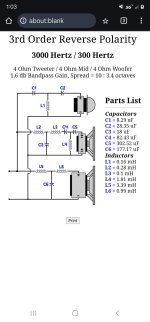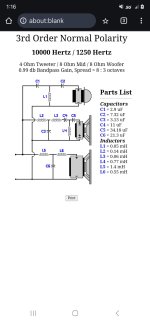I looked for a 15000uf capacitor on the internet and I couldn't find it. Does anyone know a way to get to 15000 uf? Maybe if I connect 2 capacitors in series?
Something is going wrong in the decimals. 15 milliFarad isn't a value you encounter in any passive speaker crossover network.
I think the biggest I've seen used was 2500uF, used in a 3rd order bass alignment.
Yeah, there is no reason to need a 15mF in a speaker network.
Yeah, there is no reason to need a 15mF in a speaker network.
Capacitors (equal in value) in series will have half the value.I looked for a 15000uf capacitor on the internet and I couldn't find it. Does anyone know a way to get to 15000 uf? Maybe if I connect 2 capacitors in series?
Yes, you can connect any capacitors in parallel to add the value.
However, there is something seriously wrong with your calculation of crossover values. Do not proceed in obtaining any parts, it will never work with values you posted.
Perhaps 15000 micro Farads is actually 15 micro Farads?
When I posted some old commies schematics which used 0.1mF instead of 0.1uFarad (micro), some people here were freaking out. Are you sure you are not on old commies nomenclature?
Online calculators dont work.
Wrong coil types, wrong capacitor types and values.
Wired wrong with missing components.
Wrong coil types, wrong capacitor types and values.
Wired wrong with missing components.
then maybe someone who has experience with crossover construction can make me a sketch. I'll give all the graphics from the speakers so I don't repeat the same mistake (audio components are quite expensive, I thought it was just the speakers🫣.) I could not find the graph for the tweeter the manufacturer did not give one 😕






Are you building 2way or 3way speakers?
For home or PA?
Whats is woofers and tweeters impedance?
What is target crossover frequency.
You did not mentioned midrange, are you using one?
What crossover slopes do you expect you need?
You showed very complex crossover in the first post. Is that what you want?
I can easily provide correct crossover parts values, if you provide real facts.
For home or PA?
Whats is woofers and tweeters impedance?
What is target crossover frequency.
You did not mentioned midrange, are you using one?
What crossover slopes do you expect you need?
You showed very complex crossover in the first post. Is that what you want?
I can easily provide correct crossover parts values, if you provide real facts.
I am building a 3 way speakers
For PA
The impedance is
Tweeter 4 ohm ( skar audio CX4St titanium bullet super tweeter)
Midrange 8 ohm ( Mark audio maop 11)
Woofer 4+4 ohm ( Dayton audio E180HE-44 7" DVC MMAG Extended Range Subwoofer 4 Ohm per Coil)
The subwoofer. Should play till 1500 hz
The midrange from 1500hz till 10k
The tweeter from 10k onwards
I want a very step crossover slove 3 order or higher
For PA
The impedance is
Tweeter 4 ohm ( skar audio CX4St titanium bullet super tweeter)
Midrange 8 ohm ( Mark audio maop 11)
Woofer 4+4 ohm ( Dayton audio E180HE-44 7" DVC MMAG Extended Range Subwoofer 4 Ohm per Coil)
The subwoofer. Should play till 1500 hz
The midrange from 1500hz till 10k
The tweeter from 10k onwards
I want a very step crossover slove 3 order or higher
Here is an example with real values for standard crossover. All speakers 4 ohm ( this is important, if real speakers have different resistance, you need different parts values), real crossover target 300Hz and 3kHz, which is common, but you can use other crossover points based on real frequency response of your drivers.
I did not include L-pads, which are attenuators, to match different efficiency of drivers. You will definitely need L-pad for tweeter, because you selected horn tweeter, with much higher efficiency than rest. You need to lower its response, otherwise it will be nasty, burning hole in you ear drum.
Study, learn, ask questions, provide facts, and you will one day enjoy the pleasure of listening you your own diy speakers.
Its good to start with simple project, small 2way bookshelf, where sometimes even simple crossover can do just fine, like vintage japanese one cap wonders.
I did not include L-pads, which are attenuators, to match different efficiency of drivers. You will definitely need L-pad for tweeter, because you selected horn tweeter, with much higher efficiency than rest. You need to lower its response, otherwise it will be nasty, burning hole in you ear drum.
Study, learn, ask questions, provide facts, and you will one day enjoy the pleasure of listening you your own diy speakers.
Its good to start with simple project, small 2way bookshelf, where sometimes even simple crossover can do just fine, like vintage japanese one cap wonders.
Attachments
But the subwoofer. Is 4+4 it is 8 or 4 ohm? And the amp board is 6 ohm with DSP and a program called sigma studio can I use the DSP for fine tunning?
I was reading an tread on the forum where it was speaking about reinforcement in the speaker box. Are necessary if my box is 2 cm thick and is made of fine wood that is pressed?
You need two boxes, or small sub-enclosure for midrange. Mid and woofer can not use the same box, otherwise woofer will move the cone of mid, not good.
I suggest to build two boxes, one big for two woofers, with properly calculated volume. One smaller for mid and tweeter, which can contain crossover. With input from amp and output to woofers. Offcourse big box with woofers will need bracing. Mid/tweet box not so much.
I suggest to build two boxes, one big for two woofers, with properly calculated volume. One smaller for mid and tweeter, which can contain crossover. With input from amp and output to woofers. Offcourse big box with woofers will need bracing. Mid/tweet box not so much.
- Home
- Loudspeakers
- Multi-Way
- I am a beginner and i need help with my speaker build

